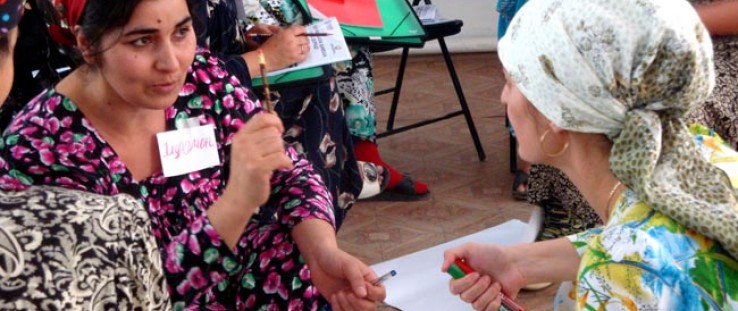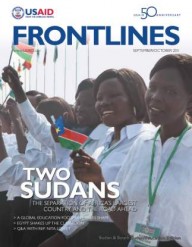 Tajik teachers learn techniques to make their classrooms more conducive to student learning.
Tajik teachers learn techniques to make their classrooms more conducive to student learning.
 Tajik teachers learn techniques to make their classrooms more conducive to student learning.
Tajik teachers learn techniques to make their classrooms more conducive to student learning.
Akosua* is 16 years old. Her mother passed away, and she lives with her grandmother in Ajumako District in Ghana. Her school uniform is patched. She wears slippers to school. Akosua’s classmates began taunting her about her appearance, pressuring her to have sex with a man in her community in exchange for money and clothes. The harsh words hurt her feelings, but didn’t break her spirit.
This scenario is common in countries like Ghana, where children are vulnerable to economic hardship, bullying, and sexual exploitation. Though anecdotal, Akosua’s story reveals a much larger issue: When youth lack skills and education, a country’s future growth is compromised. A learning environment where young people are reluctant to show up is a devastating hurdle to progress.
An obvious remedy—creating a better, safer environment for students—is at the center of a USAID program active in several countries since 2003. In Ghana and elsewhere, the Safe Schools Program is working with students, teachers, and communities to raise awareness about gender-based violence and schools.
The main asset in Safe Schools’ tool kit is a set of three manuals called Doorways, which were designed for students, volunteer community counselors, and teachers.
The student manual improves students’ resiliency and self-efficacy, and helps them prevent and respond to gender-based violence by enhancing their interpersonal communication; critical and creative thinking; and coping, conflict management, and decision-making skills. The activities in the manual provide students an opportunity to practice newly acquired skills over the course of the 50-hour program and in their lives outside the classroom. These activities, which are facilitated by a teacher, can be done during class time or after school in a community setting or a gender violence prevention club.
The community manual trains community members to help children who have been abused or in crisis by instructing them in basic listening skills and response procedures.
The third and final manual focuses on teachers, and trains them to practice teaching methodologies and attitudes that promote a safe learning environment for all students.
Manuals for Success
Used successfully in the Dominican Republic, Ghana, Malawi, Senegal, Tajikistan, and Yemen, Doorways can be incorporated into any comprehensive national or local plan to improve the classroom environment, says Julie Hanson Swanson, deputy education chief for the Africa Bureau.
For example, they can be integrated into existing programs for teacher training, Parent-Teacher Association strengthening, scholarships, support to orphans and vulnerable children, and HIV-prevention education, or as part of a comprehensive national or local plan to improve school quality.
In Tajikistan, Doorways materials were introduced as part of an existing USAID program to improve the quality of education. “We were focused on improving teaching methods and the curriculum,” said Garth Willis, an education officer in USAID’s Office of Education in Washington and former education officer for Central Asia. “But the Doorways program allowed us to look at the school environment to see other attributes that prevent learning.”
USAID worked closely with the Government of Tajikistan to support its new center on gender equality in school. “Schools must become like a home for each student, where they feel safe to share insights and develop,” added Irina Karimova, president of the Academy of Education. “We hope that in partnership with USAID, each Tajik school will turn into a home for their students.”
Through Doorways, the Safe Schools program provides teachers with the tools and skills to manage their classrooms more effectively, promoting positive discipline techniques, equitable treatment of male and female students, adherence to professional standards, and teacher codes of conduct.
A survey of 800 students and 400 teachers exposed to the program in several countries concluded that Safe Schools had “effected changes in knowledge, attitudes, and practices.”
Safety as a Strategy
Safer schools and improved learning environments directly contribute to USAID’s new Education Strategy, addressing its specific goals related to improving primary grade reading skills, and increasing equitable access to education in conflict environments.
The Progress in International Reading Literacy Study’s 2006 International Report indicates that a safe and secure school environment is a key aspect of a positive learning environment. Across the 40 countries participating in the study, on average there was a positive association between school safety and average reading achievement.
Most importantly, the program is producing real results in real students. As a result of Safe Schools and Doorways, Akosua, the young girl being bullied in Ghana, took control of her own safety and was not pressured into sex in exchange for money.
“I refused,” she said. “My teachers and especially my Gender Club patron believe I have a very bright future. This encourages me, and I continue to learn hard irrespective of my poor financial background.” She stayed in school and became a Doorways peer leader.
*The name has been changed for privacy reasons.









Comment
Make a general inquiry or suggest an improvement.